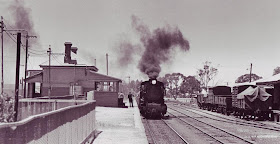The Melbourne to Adelaide or Western line runs through much of this region. It is the home of 'The Overland' passenger train. The line was extended from Ballarat to Stawell in 1876, Murtoa in 1878, Horsham in 1879, Dimboola in 1882 and linked with the South Australian Railways at the border station of Serviceton in 1887. The line was converted from broad to standard gauge in 1995.
.jpg) |
| Stawell station building at night (from "C.R.S.V.") |
 Seppelt's siding was a short distance on the Melbourne side of Great Western and served the Seppelt winery.
The buildings shown are part of Seppelt's Great Western wine complex
that was serviced by Seppelt's siding in 1981. The mountain in the
background is Mt Langi Ghiran. (from VR.net)
Seppelt's siding was a short distance on the Melbourne side of Great Western and served the Seppelt winery.
The buildings shown are part of Seppelt's Great Western wine complex
that was serviced by Seppelt's siding in 1981. The mountain in the
background is Mt Langi Ghiran. (from VR.net)Great Western passenger services ceased in August 1993 and this substantial brick station was demolished.
 |
| Great Western station, looking to Stawell, 1970 (from "VR stations & stopping places") |
.jpg) |
| Melbourne bound steam passenger train at Stawell, 1968 (from "C.R.S.V.") |
.jpg) |
| Signal boxes in the Stawell rail yards, 1984 (from "C.R.S.V.") |
 |
| Deep Lead in 1970 (from "VR stations & stopping places") |
 |
| 'Water them geraniums' the neglect of Deep Lead (from VR.net) |
Wal Wal
 |
| Wal Wal in 1981 shortly before the signals, building & platform were removed (from VR.net) |
 |
| Lubeck in 1981 (from VRnet) |
.jpg) |
| Murtoa in its heyday (from "C.R.S.V.") |
.jpg) |
| The signal box and rail motor dock platform at Murtoa in 1978 (from "C.R.S.V.") |
Jerro was north of the line, so a new railhead town of Jung or Jung Jung was established in 1878.
 |
| Jung, looking towards Murtoa 1982 (from VR.net) |
 |
| Dooen, back in 1885 (Museum Victoria's collection) |
 |
| Dooen nearly 100 years later, in 1982 (from VR.net) |
| Overlooking Horsham in 1957 (from "C.R.S.V.") |
.jpg) |
| Horsham station and yard in 1975 (from "C.R.S.V.") |
+-+Copy.JPG) |
| A quieter Horsham today - no signal box, & derelict flour mill in the distance |
Pimpinio the station buildings and goods shed have been removed, only the silos and platform mound remain.
 |
| Pimpinio station (from VR.net) |
.jpg) |
| Wail building, with the highway overpass in the background (from "C.R.S.V.") |
.jpg) |
| Dimboola looking west to the border, 1962 (from "C.R.S.V.") |
.jpg) |
| Station building & signal box in 1971 (from "C.R.S.V.") |
 |
| The station building now |
Gerang Gerung even the platform mound has been demolished at Gerang, with the silos the only evidence of the station.
 |
| Serviceton passenger service at Gerang in 1976(VRnet) |
 |
| Track gang near Kiata in 1968 (from "Patterns of steam") |
 |
| The Salisbury silo in the foreground with the Kiata silo in the distance |
 |
| A goods train at Salisbury, 1986 (from VR.net) |
 |
| Nhill station building |
+-+Copy.JPG) |
| The rusting rails of the Tarranginnie siding beside the main line |
 |
| Diapur station building in 1971 (from "VR stations & stopping places") |
 |
| The weigh-bridge & water-tank at Diapur |
+-+Copy.JPG) |
| The Miram West Rd crosses the tracks approaching Miram |
+-+Copy.JPG) |
| A boarded-up Kaniva station building |
 |
| Dimboola-Serviceton goods train at Kaniva, 1967 (from "Patterns of steam") |
+-+Copy.JPG) |
| Changes - the same view today |
 |
| An already derelict looking Lillimur in 1971 (from "VR stations & stopping places") |
.jpg) |
| Passenger train stopped at Serviceton, 1961 (from "C.R.S.V.") |
.jpg) | |
| Post-steam Serviceton in 1978 (from "C.R.S.V.") |
 |
| Serviceton now |

+-+Copy.JPG)
.jpg)
+-+Copy.JPG)
I enjoyed the write up.
ReplyDeleteThanks!